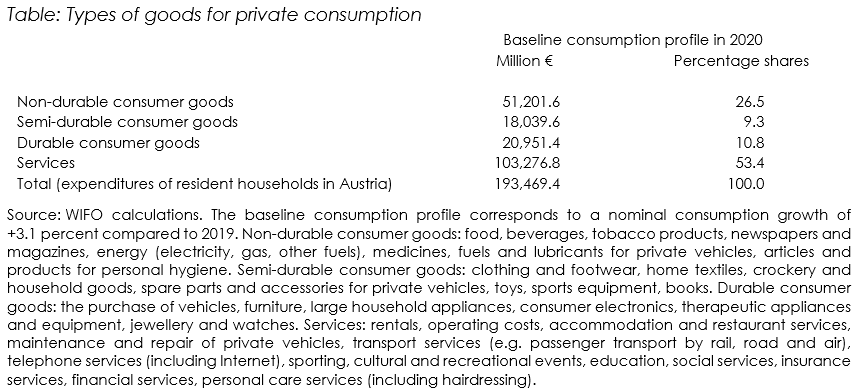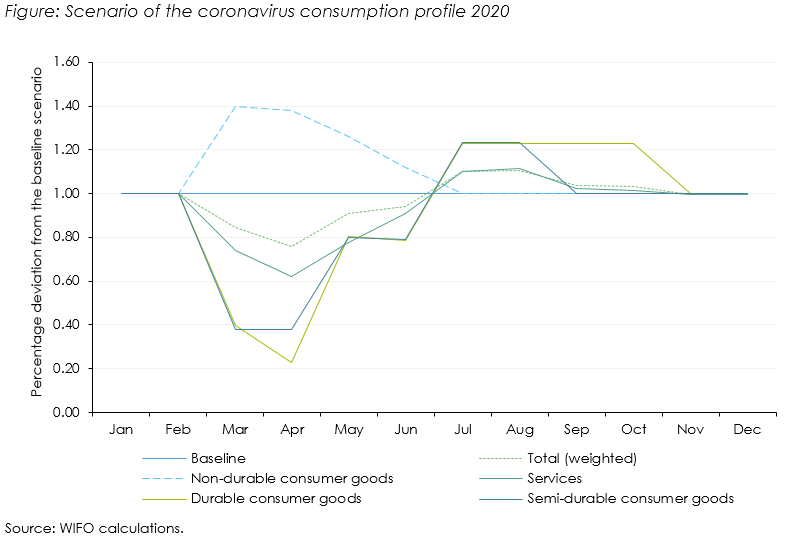
Private Consumption in Times of the Corona Crisis and Afterwards
The economic effects of the COVID-19 measures taken to date are felt in all areas of the domestic economy. The cause is a supply shock, which primarily affects the market service sectors (especially trade, transport, tourism, entertainment and leisure, personal services). The supply shock also directly affects private households on the demand side, as the measures require changes in consumer behaviour. This applies not only to the duration of the COVID-19 measures, but also to the months afterwards.
The assessment of the effects on the consumption expenditure of domestic households and on the expenditure of foreign guests in Austria this year is based on the following system and approach:
-
Detailed structural expenditure information is available for domestic households on an annual basis as well as quarterly according to the COICOP (Classification of Individual Consumption by Purpose) breakdown.
-
This level of detail in the consumption data makes it possible to estimate or define a monthly consumption path for the individual expenditure items according to the assumed scenario, which on the one hand is based on the time profile of the defined measures, but on the other hand also includes expected "catch-up consumption" for certain categories and also takes into account the phase of normalisation – i.e. the return to the accustomed consumption pattern.
-
The consumption profile is based on the following baseline scenario: six-week shutdown until the end of April, partial opening of closed stores in May, return to "normal operation" from June.
-
In a further step, expenditure volumes can be derived from the coronavirus consumption profile and compared with a baseline consumption profile. The baseline consumption profile corresponds to a nominal consumption growth of +3.1 percent compared to 2019.
-
The deviation from the baseline represents the consumer demand shock in billion €.
-
On the production side, this volume can be attributed to the trade and services sectors as a change in sales and, as a result, the value-added loss or gain induced by the change in consumption can be estimated for the individual sectors.
Baseline: shares, orders of magnitude, outlines
Private consumption is the most important component of GDP on the demand side. In 2019, nominal private consumption, including non-profit institutions serving households (NPISH), amounted to 205.8 billion €; this corresponds to slightly more than half of GDP. Expenditures of resident households in Austria accounts for 91 percent, with the remaining 9 percent divided equally between consumption expenditure of Austrian residents abroad and the NPISH.
The supply shock affects different sectors to varying degrees, with service sectors being particularly affected by the shutdown, as more than half of private consumption expenditure is channelled into the service sector. About a quarter is spent on everyday necessities and about 10 percent each on semi-durable and durable consumer goods.

Definition of a consumption profile
For each COICOP 4-digit consumer expenditure item (more than 100 items in total) an expenditure path for 2020 is defined on a monthly basis. The target figure is the consumption of resident households in Austria. A factor of 1 means that the expenditure in the respective month corresponds to that of an average month (year-twelfths), a factor of 1.5 means a 50 percent higher consumption and 0.1 means a consumption that is 90 percent below average. These consumption paths are then aggregated according to the types of consumer goods (non-durable, semi-durable and durable consumer goods and services) and the corresponding consumption volumes derived.

The months of January and February are defined as average months, starting from March, overall consumption falls, the strongest fall is in April, and from July the consumption path to October is greater than 1; November and December are defined as average months.
The presentation by type of consumer goods shows significant differences:
-
Non-durable consumer goods are expected to rise sharply in the months March to May. This is due to higher spending in the food, beverages and personal care sector, where shops are also still open. Only a small part of the increase in consumption in this area is due to consumers' hoarding purchases; rather, this is additional spending on food to eat at home seven days a week during this period, rather than eating out (e.g. in restaurants, guesthouses, company canteens). Over the year, consumption expenditure in this category increases by 10 percent.
-
Semi-durable consumer goods are expected to experience a sharp decline in March and April, especially in the clothing and footwear sector (almost 60 percentage share of this group). In May and June, consumer spending is expected to remain subdued, with some reluctance to buy in the summer months. Overall, consumer spending is likely to be 10 percent below the baseline scenario.
-
In the case of durable consumer goods, a somewhat more pronounced reluctance to spend is immediately assumed, as purchases in this area tend to account for larger sums and this additionally inhibits the willingness to spend in times of great uncertainty. Moreover, many of the products (such as new cars or furniture) cannot be sold 1:1 via pure online sales (as a possible substitution for stationary retail). It is assumed, however, that there will be a longer phase of stronger follow-on purchases in autumn 2020. All in all, however, this group is also expected to see a decline (–7 percent) in spending volume over the year.
-
In services, the consumption profile is noticeably more subdued from March to June. It is assumed that spending on transport services, tourism, catering and entertainment (sport, leisure, culture) will slump significantly, especially in March and April. But services also include expenditure on housing (rent, operating costs: in each case a share of 37 percent), and these are by and large not affected by the shutdown. Services also include expenditure on health (doctors, therapies, hospital). Here it is assumed that these will increase temporarily. Follow-up effects are only priced in to a small extent in the services, as a large part of the unused consumption cannot be made up for. Overall, the expenditure level is 94 percent of the reference value.
Magnitude of the consumer demand shock – expenditures of resident households
Based on the assumed consumption profile, there is a demand shock for domestic spending by resident households totalling 4.5 billion €.
The COVID-19 measures taken do not only affect domestic consumption expenditure but also the expenditure of resident households abroad. Due to the travel restrictions that prevail worldwide as well as the uncertainties, a strong decline in travel activities is also expected in the coming months. These expenditures are expected to decrease by more than 1.5 billion €, which corresponds to a decline of almost 16 percent over the year.
Private household consumption also includes expenditure of non-profit organisations serving households (such as the Red Cross), church associations or clubs. In the government's first (emergency) aid package (4 billion €), we assume that funds will also flow to health facilities and organisations within the NPISH. An amount of +500 million € has been assumed, which will support consumption.
Thus, the total demand shock based on private consumption amounts to 5.5 billion €.
Magnitude of the consumer demand shock – foreign guests
For the determination of the value-added effects, not only the loss of consumption of the domestic population is relevant, but also that of foreign guests. For this purpose, an estimate must be made of how strongly overnight stays in tourism are affected by the corona crisis. On the basis of an assumed overnight stay scenario, a factor of increase or decrease in consumption per COICOP consumption item can then be determined, similar to the consumption profile of Austrian resident households.
Among the top ten expenditure items among foreign tourists, the main part is accounted for by accommodation and catering, followed by sport, leisure and culture, transport expenditure, clothing and goods for daily use. For the year, travel exports (consumption of foreign guests in Austria) are expected to be about 2.9 billion € lower.
Conclusion
An exact economic assessment of the measures that became necessary as a result of the coronavirus pandemic is difficult to make at this stage. Scenarios can only reveal a certain magnitude here. The assumed consumption profile includes uncertainties on many levels: actual duration of the crisis, changes in household consumption patterns, effectiveness of economic policy measures, etc. The fact is, however, that even in the current scenario the consumption demand shock assumes a volume that can be described as the biggest shock to the domestic economy in recent decades.
























